Briggs & Stratton 13500 User Manual
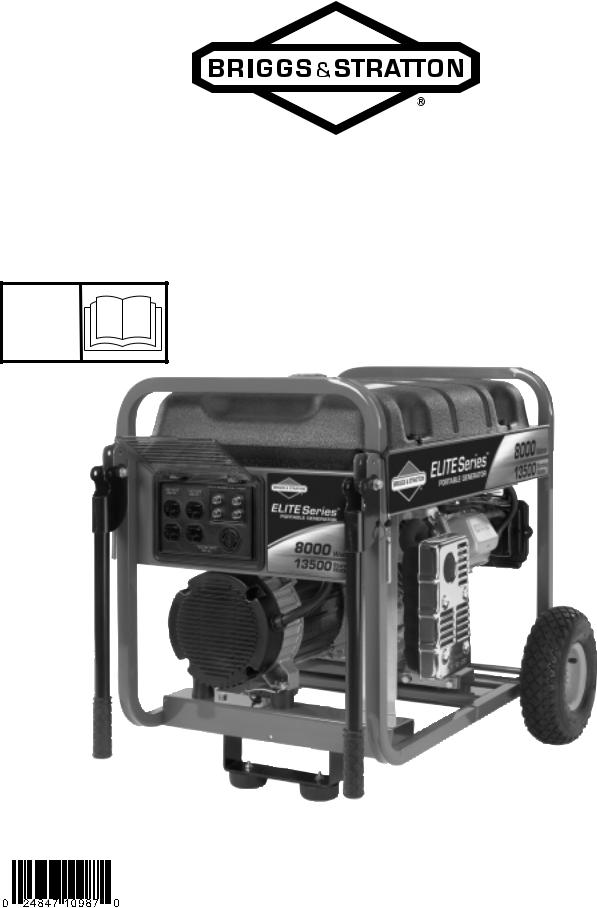
8000 Watt Portable Generator
Operator’s Manual
BRIGGS & STRATTON POWER PRODUCTS GROUP, LLC
JEFFERSON, WISCONSIN, U.S.A.
Printed in U.S.A. Manual No. 195693GS Revision E (05/29/2007)

Thank you for purchasing this quality-built Briggs & Stratton generator. We are pleased that you’ve placed your confidence in the Briggs & Stratton brand. When operated and maintained according to the instructions in this manual, your Briggs & Stratton generator will provide many years of dependable service.
This manual contains safety information to make you aware of the hazards and risks associated with generator products and how to avoid them. This generator is designed and intended only for supplying electrical power for operating compatible electrical lighting, appliances, tools and motor loads, and is not intended for any other purpose. It is important that you read and understand these instructions thoroughly before attempting to start or operate this equipment. Save these instructions for future reference.
This generator requires final assembly before use. Refer to the Assembly section of this manual for instructions on final assembly procedures. Follow the instructions completely.
Where to Find Us
You never have to look far to find Briggs & Stratton support and service for your generator. Consult your Yellow Pages. There are over 30,000 Briggs & Stratton authorized service dealers worldwide who provide quality service. You can also contact Briggs & Stratton Customer Service by phone at (800) 743-4115 or on the Internet at BRIGGSandSTRATTON.COM.
Generator
Model Number
Revision
Serial Number
Engine
Model Number
Type Number
Code Number
Date Purchased
Briggs & Stratton Power Products Group, LLC
900 North Parkway
Jefferson, WI 53549
Copyright © 2007 Briggs & Stratton Power Products Group, LLC. All rights reserved. No part of this material may be reproduced or transmitted in any form by any means without the express written permission of Briggs & Stratton Power Products Group, LLC.
2 |
BRIGGSandSTRATTON.COM |

Table of Contents
Operator Safety . . . . . . . . . . . . . . . . . . . . . . . . . . . . . . . . . 4
Equipment Description. . . . . . . . . . . . . . . . . . . . . . . . . . . . . . . . . . . . . . . . . 4
Safety Rules. . . . . . . . . . . . . . . . . . . . . . . . . . . . . . . . . . . . . . . . . . . . . . . . . 4
Assembly . . . . . . . . . . . . . . . . . . . . . . . . . . . . . . . . . . . . . 7
Unpack Generator . . . . . . . . . . . . . . . . . . . . . . . . . . . . . . . . . . . . . . . . . . . . 7 Install Wheel Kit. . . . . . . . . . . . . . . . . . . . . . . . . . . . . . . . . . . . . . . . . . . . . . 7 Add Engine Oil . . . . . . . . . . . . . . . . . . . . . . . . . . . . . . . . . . . . . . . . . . . . . . . 8 Add Fuel. . . . . . . . . . . . . . . . . . . . . . . . . . . . . . . . . . . . . . . . . . . . . . . . . . . . 8 Attach Negative Battery Cable . . . . . . . . . . . . . . . . . . . . . . . . . . . . . . . . . . . 9 System Ground . . . . . . . . . . . . . . . . . . . . . . . . . . . . . . . . . . . . . . . . . . . . . . 9 Connecting to a Building’s Electrical System. . . . . . . . . . . . . . . . . . . . . . . . 9 Generator Location . . . . . . . . . . . . . . . . . . . . . . . . . . . . . . . . . . . . . . . . . . 10
Features and Controls . . . . . . . . . . . . . . . . . . . . . . . . . . . . 11
Cord Sets and Receptacles . . . . . . . . . . . . . . . . . . . . . . . . . . . . . . . . . . . . 12
Battery Float Charger . . . . . . . . . . . . . . . . . . . . . . . . . . . . . . . . . . . . . . . . . 13
Operation . . . . . . . . . . . . . . . . . . . . . . . . . . . . . . . . . . . . 14
Starting the Engine . . . . . . . . . . . . . . . . . . . . . . . . . . . . . . . . . . . . . . . . . . 14
Connecting Electrical Loads. . . . . . . . . . . . . . . . . . . . . . . . . . . . . . . . . . . . 15
Oil Pressure Shutdown . . . . . . . . . . . . . . . . . . . . . . . . . . . . . . . . . . . . . . . 15
Stopping the Engine. . . . . . . . . . . . . . . . . . . . . . . . . . . . . . . . . . . . . . . . . . 15
Cold Weather Operation. . . . . . . . . . . . . . . . . . . . . . . . . . . . . . . . . . . . . . . 15
Don’t Overload Generator . . . . . . . . . . . . . . . . . . . . . . . . . . . . . . . . . . . . . 17
Maintenance . . . . . . . . . . . . . . . . . . . . . . . . . . . . . . . . . . 18
Maintenance Schedule . . . . . . . . . . . . . . . . . . . . . . . . . . . . . . . . . . . . . . . . 18
Generator Maintenance . . . . . . . . . . . . . . . . . . . . . . . . . . . . . . . . . . . . . . . 18
Battery Maintenance . . . . . . . . . . . . . . . . . . . . . . . . . . . . . . . . . . . . . . . . . 19
Engine Maintenance. . . . . . . . . . . . . . . . . . . . . . . . . . . . . . . . . . . . . . . . . . 19
Storage . . . . . . . . . . . . . . . . . . . . . . . . . . . . . . . . . . . . . . . . . . . . . . . . . . . 22
Troubleshooting . . . . . . . . . . . . . . . . . . . . . . . . . . . . . . . . 23
Warranties. . . . . . . . . . . . . . . . . . . . . . . . . . . . . . . . . . . . 24
Emissions Control System Warranty . . . . . . . . . . . . . . . . . . . . . . . . . . . . . 24
Generator Owner Warranty . . . . . . . . . . . . . . . . . . . . . . . . . . . . . . . . . . . . 26
Specifications . . . . . . . . . . . . . . . . . . . . . . . . . . . . . . . . . 28
Product Specifications . . . . . . . . . . . . . . . . . . . . . . . . . . . . . . . . . . . . . . . . 28
Common Service Parts . . . . . . . . . . . . . . . . . . . . . . . . . . . . . . . . . . . . . . . 28
Español
3
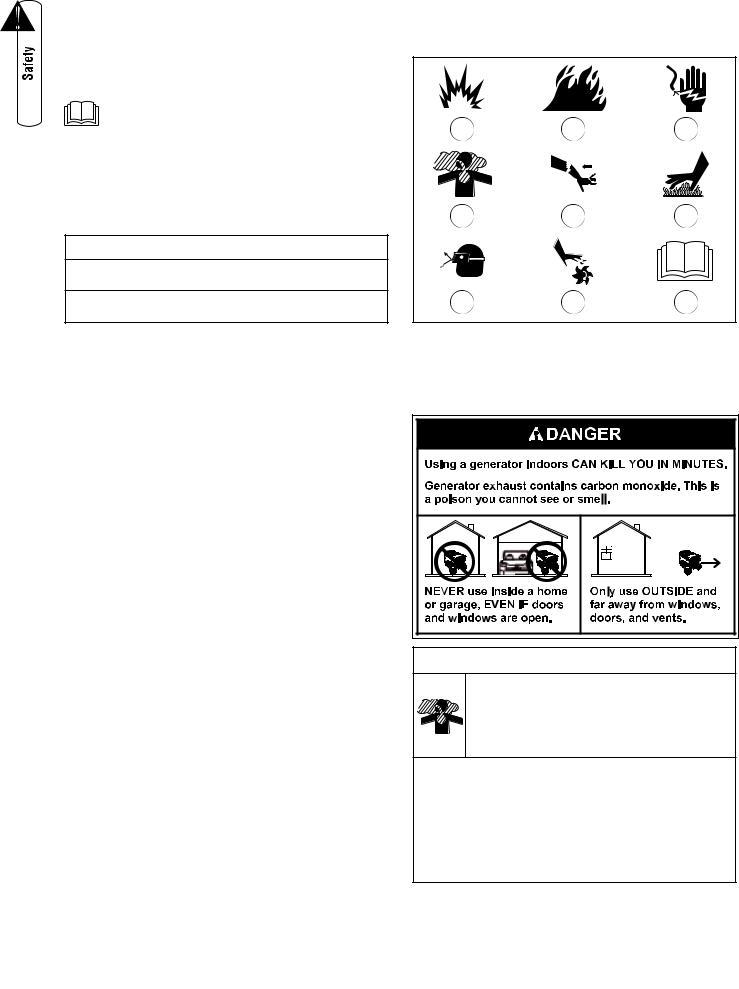
Operator Safety
Equipment Description
Read this manual carefully and become familiar with your generator. Know its applications, its limitations and any hazards involved.
The generator is an engine–driven, revolving field, alternating current (AC) generator. It was designed to supply electrical power for operating compatible electrical lighting, appliances, tools and motor loads. The generator’s revolving field is driven at about 3,600 rpm by a single-cylinder engine.
NOTICE
Exceeding generators wattage/amperage capacity can damage generator and/or electrical devices connected to it.
•DO NOT exceed the generator’s wattage/amperage capacity. See
Don’t Overload Generator in the Operation section.
Every effort has been made to ensure that the information in this manual is both accurate and current. However, the manufacturer reserves the right to change, alter or otherwise improve the generator and this documentation at any time without prior notice.
The Emission Control System for this generator is warranted for standards set by the Environmental Protection Agency and the California Air Resources Board.
Safety Rules
This is the safety alert symbol. It is used to alert you to potential personal injury hazards. Obey all safety messages that follow this symbol to avoid possible injury or death.
The safety alert symbol ( ) is used with a signal word (DANGER, WARNING, CAUTION), a pictorial and/or a safety message to alert you to hazards. DANGER indicates a hazard which, if not avoided, will result in death or serious injury. WARNING indicates a hazard which, if not avoided, could result in death or serious injury. CAUTION indicates a hazard which, if not avoided, might result in minor or moderate injury. NOTICE indicates a situation that could result in equipment damage. Follow safety messages to avoid or reduce the risk of injury or death.
) is used with a signal word (DANGER, WARNING, CAUTION), a pictorial and/or a safety message to alert you to hazards. DANGER indicates a hazard which, if not avoided, will result in death or serious injury. WARNING indicates a hazard which, if not avoided, could result in death or serious injury. CAUTION indicates a hazard which, if not avoided, might result in minor or moderate injury. NOTICE indicates a situation that could result in equipment damage. Follow safety messages to avoid or reduce the risk of injury or death.
The manufacturer cannot possibly anticipate every possible circumstance that might involve a hazard. The warnings in this manual, and the tags and decals affixed to the unit are, therefore, not all-inclusive. If you use a procedure, work method or operating technique that the manufacturer does not specifically recommend, you must satisfy yourself that it is safe for you and others. You must also make sure that the procedure, work method or operating technique that you choose does not render the generator unsafe.
Hazard Symbols and Meanings
A |
B |
C |
D |
E |
F |
G |
H |
J |
A - Explosion |
F - Hot Surface |
|
B - Fire |
G - Flying Objects |
|
C - Electric Shock |
H - Moving Parts |
|
D - Toxic Fumes |
J - Read Manual |
|
E - Kickback |
|
|
|
WARNING |
|
Running engine gives off carbon monoxide, an odorless, colorless, poison gas.
Breathing carbon monoxide can cause headache, fatigue, dizziness, vomiting, confusion, seizures, nausea, fainting or death.
•Operate generator ONLY outdoors.
•Install a battery operated carbon monoxide alarm near the bedrooms.
•Keep exhaust gas from entering a confined area through windows, doors, ventilation intakes, or other openings.
•DO NOT start or run engine indoors or in an enclosed area, (even if windows and doors are open), including the generator compartment of a recreational vehicle (RV).
4 |
BRIGGSandSTRATTON.COM |
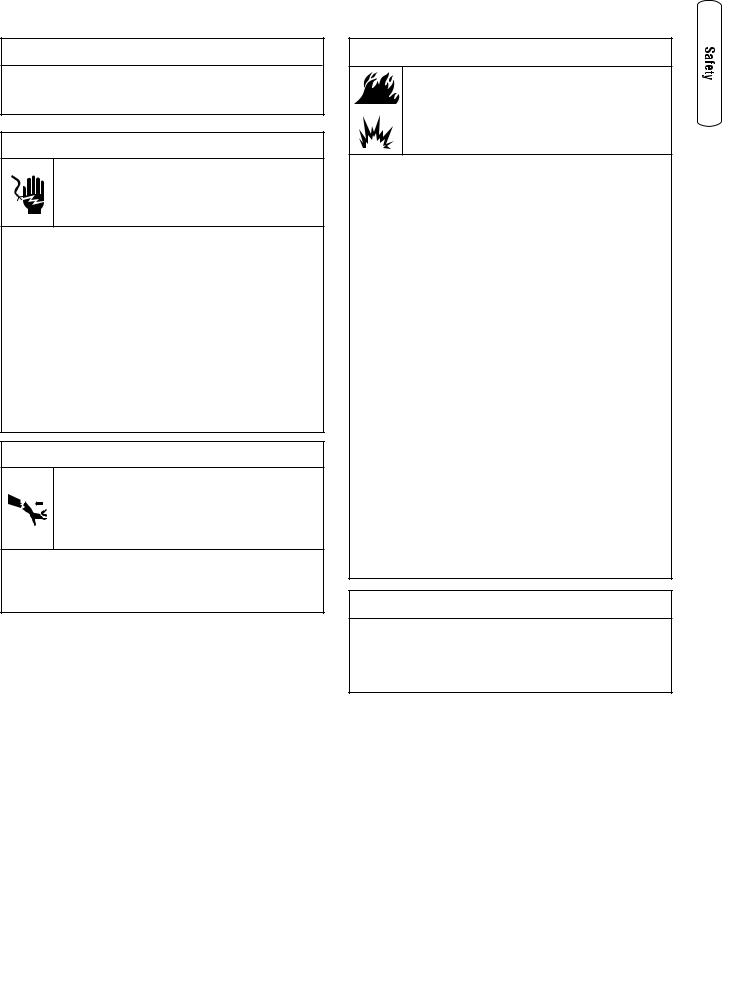
 WARNING
WARNING
The engine exhaust from this product contains chemicals known to the State of California to cause cancer, birth defects, or other reproductive harm.
 WARNING
WARNING
Generator produces hazardous voltage.
Failure to isolate generator from power utility can result in death or injury to electric utility workers due to backfeed of electrical energy.
•When using generator for backup power, notify utility company. Use approved transfer equipment to isolate generator from electric utility.
•Use a ground fault circuit interrupter (GFCI) in any damp or highly conductive area, such as metal decking or steel work.
•DO NOT touch bare wires or receptacles.
•DO NOT use generator with electrical cords which are worn, frayed, bare or otherwise damaged.
•DO NOT operate generator in the rain or wet weather.
•DO NOT handle generator or electrical cords while standing in water, while barefoot, or while hands or feet are wet.
•DO NOT allow unqualified persons or children to operate or service generator.
 WARNING
WARNING
Starter cord kickback (rapid retraction) can result in bodily injury. Kickback will pull hand and arm toward engine faster than you can let go.
Broken bones, fractures, bruises, or sprains could result.
•When starting engine, pull cord slowly until resistance is felt and then pull rapidly to avoid kickback.
•NEVER start or stop engine with electrical devices plugged in and turned on.
 WARNING
WARNING
 Fuel and its vapors are extremely flammable and explosive.
Fuel and its vapors are extremely flammable and explosive.
Fire or explosion can cause severe burns or death.
WHEN ADDING OR DRAINING FUEL
•Turn generator OFF and let it cool at least 2 minutes before removing fuel cap. Loosen cap slowly to relieve pressure in tank.
•Fill or drain fuel tank outdoors.
•DO NOT overfill tank. Allow space for fuel expansion.
•If fuel spills, wait until it evaporates before starting engine.
•Keep fuel away from sparks, open flames, pilot lights, heat, and other ignition sources.
•DO NOT light a cigarette or smoke.
WHEN STARTING EQUIPMENT
•Ensure spark plug, muffler, fuel cap, and air cleaner are in place.
•DO NOT crank engine with spark plug removed.
WHEN OPERATING EQUIPMENT
•DO NOT tip engine or equipment at angle which causes fuel to spill.
•This generator is not for use in mobile equipment or marine applications.
WHEN TRANSPORTING OR REPAIRING EQUIPMENT
•Transport/repair with fuel tank EMPTY or with fuel shutoff valve OFF.
•Disconnect spark plug wire.
WHEN STORING FUEL OR EQUIPMENT WITH FUEL IN TANK
•Store away from furnaces, stoves, water heaters, clothes dryers, or other appliances that have pilot light or other ignition source because they can ignite fuel vapors.
 WARNING
WARNING
•This generator does not meet U. S. Coast Guard Regulation 33CFR-183 and should not be used on marine applications.
•Failure to use the appropriate U. S. Coast Guard approved generator could result in death or serious injury and/or property damage.
5

 WARNING
WARNING
Contact with muffler area can result in serious burns.
Exhaust heat/gases can ignite combustibles, structures or damage fuel tank causing a fire.
•DO NOT touch hot parts and AVOID hot exhaust gases.
•Allow equipment to cool before touching.
•Keep at least 5 feet (1.5 m) of clearance on all sides of generator including overhead.
•Code of Federal Regulation (CFR) Title 36 Parks, Forests, and Public Property require equipment powered by an internal combustion engine to have a spark arrester, maintained in effective working order, complying to USDA Forest service standard 5100-1C or later revision. In the State of California a spark arrester is required under section 4442 of the California Public resources code. Other states may have similar laws.
 WARNING
WARNING
Starter and other rotating parts can entangle hands, hair, clothing, or accessories.
•NEVER operate generator without protective housing or covers.
•DO NOT wear loose clothing, jewelry or anything that may be caught in the starter or other rotating parts.
•Tie up long hair and remove jewelry.
 WARNING
WARNING
Unintentional sparking can result in fire or electric shock.
WHEN ADJUSTING OR MAKING REPAIRS TO YOUR GENERATOR
•Disconnect the spark plug wire from the spark plug and place the wire where it cannot contact spark plug.
WHEN TESTING FOR ENGINE SPARK
•Use approved spark plug tester.
•DO NOT check for spark with spark plug removed.
 CAUTION
CAUTION
Excessively high operating speeds increase risk of injury and damage to generator.
Excessively low speeds impose a heavy load.
•DO NOT tamper with governed speed. Generator supplies correct rated frequency and voltage when running at governed speed.
•DO NOT modify generator in any way.
NOTICE
Exceeding generators wattage/amperage capacity can damage generator and/or electrical devices connected to it.
•DO NOT exceed the generator’s wattage/amperage capacity. See
Don’t Overload Generator in the Operation section.
•Start generator and let engine stabilize before connecting electrical loads.
•Connect electrical loads in OFF position, then turn ON for operation.
•Turn electrical loads OFF and disconnect from generator before stopping generator.
NOTICE
Improper treatment of generator can damage it and shorten its life.
•Use generator only for intended uses.
•If you have questions about intended use, ask dealer or contact local service center.
•Operate generator only on level surfaces.
•DO NOT expose generator to excessive moisture, dust, dirt, or corrosive vapors.
•DO NOT insert any objects through cooling slots.
•If connected devices overheat, turn them off and disconnect them from generator.
•Shut off generator if:
-electrical output is lost;
-equipment sparks, smokes, or emits flames; -unit vibrates excessively.
6 |
BRIGGSandSTRATTON.COM |

Assembly
Your generator requires some assembly and is ready for use after it has been properly serviced with the recommended fuel and oil.
If you have any problems with the assembly of your generator, please call the generator helpline at (800) 743-4115. If calling for assistance, please have the model, revision, and serial number from the data tag available. See Controls and Features for data tag location.
Install the wheel kit as follows:
1.Tip generator so that generator rests on frame with engine end up.
2.Slide axle (A) through both mounting brackets.
3.Slide a wheel (B) over the axle.
NOTE: Be sure to install both wheels with the air pressure valve on the outboard side.
4.Place a washer (C) on axle and then place an e-ring (D) in axle groove.
Unpack Generator
1.Set the carton on a rigid, flat surface.
2.Remove everything from carton except generator and confirm all listed parts are present.
3.Open carton completely by cutting each corner from top to bottom.
4.Leave generator on carton to install wheel kit.
The generator is supplied with:
•Operator’s manual
•Battery float charger
•Oil bottles
•Wheel kit
Install Wheel Kit
NOTE: Wheel kit is not intended for over-the-road use.
You will need the following tools to install these components:
•7/16” and 13mm socket wrench
•7/16” and 13mm open end wrench
•Pliers
•Safety glasses
 CAUTION
CAUTION
E-rings can cause eye injury.
 E-rings can spring back and become airborne when installing or removing.
E-rings can spring back and become airborne when installing or removing.
•Always wear eye protection when installing/removing e-rings.
5.Install e-ring with pliers, squeezing from top of e-ring to bottom of axle.
6.Repeat step 3 thru 5 to secure second wheel.
7.Tip generator so that generator rests on frame with engine side down.
8.Attach the vibration mounts (E) to the support leg (F) with 1/4-20 x 1” capscrews (G) and 1/4-20 lock nuts (H).
9.Attach support leg with M8 x 20 mm cap screws (J) and M8 lock nuts (K).
10.Return generator to normal operating position (resting on wheels and support leg).
11.Check each fastener to ensure it is secure and the tires are inflated between 15-40 PSI.
B
C
A
H

J
F
D
E
G 

 K
K
7
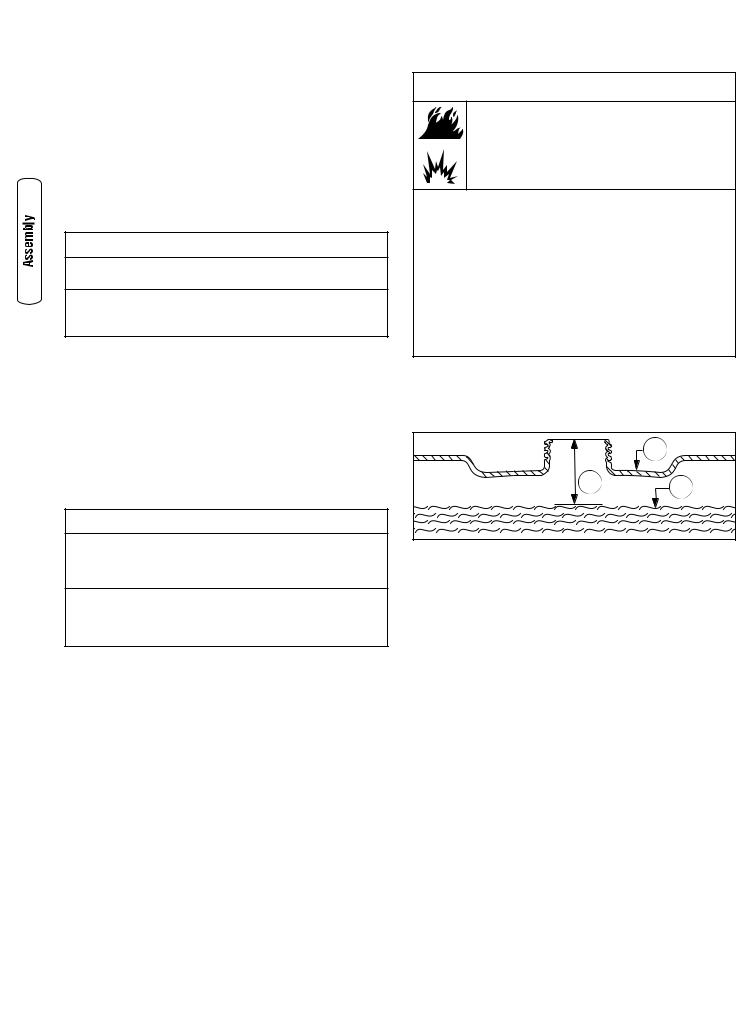
Add Engine Oil
1.Place generator on a flat, level surface.
2.Clean area around oil fill and remove yellow oil fill cap.
NOTE: See Oil in Engine Maintenance to review oil recommendations. Verify provided oil bottle is correct viscosity for current ambient temperature.
3.Using oil funnel (optional), slowly pour contents of provided oil bottle into oil fill opening until oil level reaches the “Full” mark on the dipstick.
NOTICE
Improper treatment of generator can damage it and shorten its life.
•DO NOT attempt to crank or start the engine before it has been properly serviced with the recommended oil. This may result in an engine failure.
4.Replace oil fill cap and fully tighten.
Add Fuel
Fuel must meet these requirements:
•Clean, fresh, unleaded gasoline.
•A minimum of 87 octane/87 AKI (91 RON). High altitude use, see High Altitude.
•Gasoline with up to 10% ethanol (gasohol) or up to 15% MTBE (methyl tertiary butyl ether) is acceptable.
NOTICE
Avoid generator damage.
Failure to follow Operator’s Manual for fuel recommendations voids warranty.
•DO NOT use unapproved gasoline such as E85 or E22.
•DO NOT mix oil in gasoline.
•DO NOT modify engine to run on alternate fuels.
To protect the fuel system from gum formation, mix in a fuel stabilizer when adding fuel. See Storage. All fuel is not the same. If you experience starting or performance problems after using fuel, switch to a different fuel provider or change brands. This engine is certified to operate on gasoline. The emission control system for this engine is EM (Engine Modifications).
 WARNING
WARNING
 Fuel and its vapors are extremely flammable and explosive.
Fuel and its vapors are extremely flammable and explosive.
Fire or explosion can cause severe burns or death.
WHEN ADDING FUEL
•Turn generator OFF and let it cool at least 2 minutes before removing fuel cap. Loosen cap slowly to relieve pressure in tank.
•Fill fuel tank outdoors.
•DO NOT overfill tank. Allow space for fuel expansion.
•If fuel spills, wait until it evaporates before starting engine.
•Keep fuel away from sparks, open flames, pilot lights, heat, and other ignition sources.
•DO NOT light a cigarette or smoke.
1.Clean area around fuel fill cap, remove cap.
2.Slowly add unleaded gasoline (A) to fuel tank (B). Be careful not to overfill. Allow about 1.5" (4 cm) of tank space (C) for fuel expansion.
|
B |
C |
A |
|
3.Install fuel cap and let any spilled fuel evaporate before starting engine.
High Altitude
At altitudes over 5,000 feet (1524 meters), a minimum 85 octane / 85 AKI (89 RON) gasoline is acceptable. To remain emissions compliant, high altitude adjustment is required. Operation without this adjustment will cause decreased performance, increased fuel consumption, and increased emissions. See an authorized dealer for high
altitude adjustment information. Operation of the engine at altitudes below 2,500 feet (762 meters) with the high altitude kit is not recommended.
8 |
BRIGGSandSTRATTON.COM |
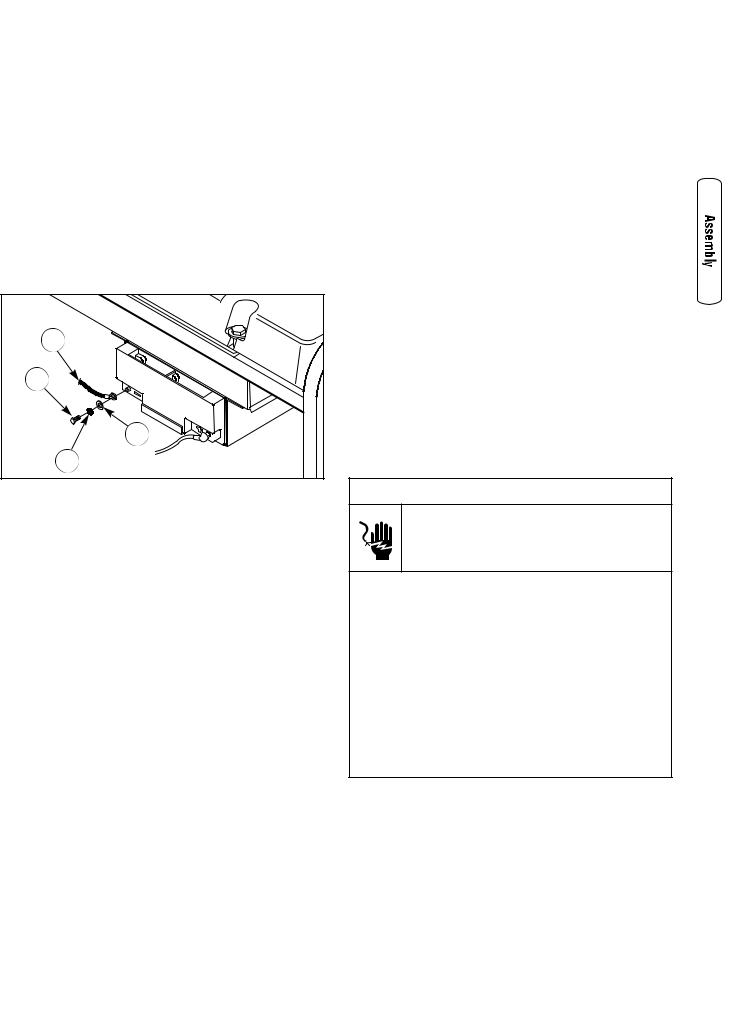
Attach Negative Battery Cable
Your unit is equipped with electric start capability but can be started manually. If you choose not to use the electric start feature, you do not need to connect the negative battery cable.
The sealed battery on the generator pre–installed except for the negative (black) battery cable.
To install:
1.Cut off tie wrap securing loose end of negative (black) cable.
2.Remove screw (A), lock washer (B) and flat washer (C) on negative battery terminal.
D |
A |
C |
B |
3.Slide lock washer, flat washer and negative battery cable (D) over screw.
4.Reattach screw to negative battery terminal and tighten.
5.Verify that connections to battery and generator are tight and secure.
NOTE: If your battery is discharged, charge prior to use following the instructions in the section Battery Float Charger.
System Ground
The generator has a system ground that connects the generator frame components to the ground terminals on the AC output receptacles. The system ground is connected to the AC neutral wire (the neutral is bonded to the generator frame).
Special Requirements
There may be Federal or State Occupational Safety and Health Administration (OSHA) regulations, local codes, or ordinances that apply to the intended use of the generator. Please consult a qualified electrician, electrical inspector, or the local agency having jurisdiction:
•In some areas, generators are required to be registered with local utility companies.
•If the generator is used at a construction site, there may be additional regulations which must be observed.
Connecting to a Building’s Electrical System
Connections for standby power to a building’s electrical system must be made by a qualified electrician. The connection must isolate the generator power from utility power or other alternative power sources and must comply with all applicable laws and electrical codes.
 WARNING
WARNING
Generator produces hazardous voltage.
Failure to isolate generator from power utility can result in death or injury to electric utility workers due to backfeed of electrical energy.
•When using generator for backup power, notify utility company. Use approved transfer equipment to isolate generator from electric utility.
•Use a ground fault circuit interrupter (GFCI) in any damp or highly conductive area, such as metal decking or steel work.
•DO NOT touch bare wires or receptacles.
•DO NOT use generator with electrical cords which are worn, frayed, bare or otherwise damaged.
•DO NOT operate generator in the rain or wet weather.
•DO NOT handle generator or electrical cords while standing in water, while barefoot, or while hands or feet are wet.
•DO NOT allow unqualified persons or children to operate or service generator.
9
